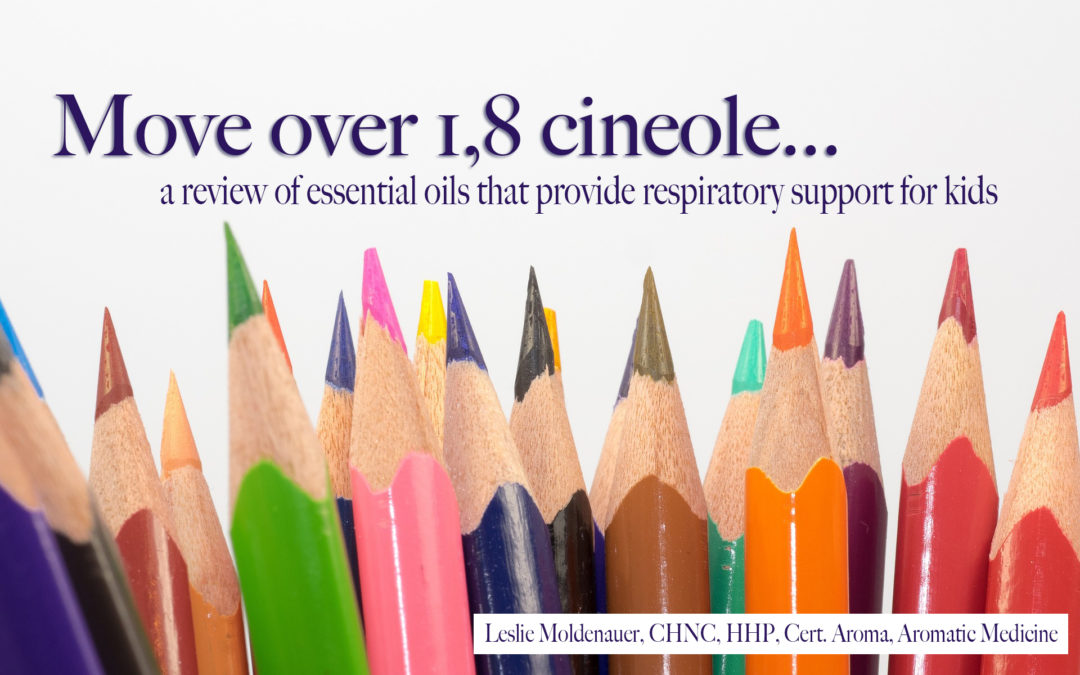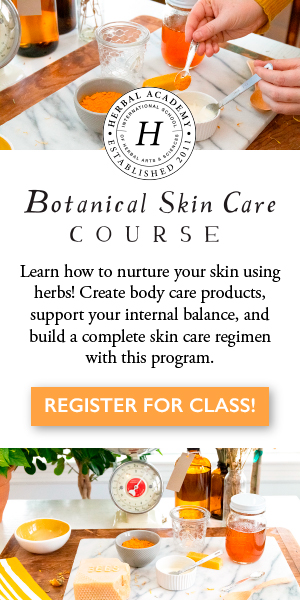Aromatherapists have written articles about the safety of the constituent 1,8 cineole, specifically Eucalyptus radiata, Eucalyptus globulus, and Eucalyptus smithii. You’ll read plenty of articles as to why this constituent is not safe for children and not to use it at all under the age of 10. This is not, however, an accurate statement. The caution that is given from Robert Tisserand in his book entitled Essential Oil Safety 2e concerning Eucalyptus essential oil, and any other oil considered high in 1,8 cineole is to not apply on or near the face of a child under 10, (1) which is very different than do not use. No 1,8 cineole? Other respiratory essential oils for kids.
Rather than reinvent the wheel in this article and tell you why you should not be using Eucalyptus on a child, (which I believe that you absolutely can do), this article is going to speak to which essential oils are a great replacement for oils high in 1,8 cineole when your child needs respiratory system support, so you can feel confident and empowered and use these powerful tools for good.
*For more information on Eucalyptus, see the well-written article referenced below by Jade Shutes of The School for Aromatic Studies.
Now, let’s take a look at which essential oils we can use to help support the respiratory system of our children while taking the concern of 1,8 cineole out of the picture.
The first essential oil I would like to cover is Cedarwood, specifically Cedarwood Atlas:
Cedarwood Atlas: Cedrus Atlantica
Aroma: Balsamic, woody, sweet and spicy
Chemistry: Cedarwood Atlas contains approximately 50% β-himachalene, which is a sesquiterpene, and has 15 carbon atoms. Typically, sesquiterpenes have anti-inflammatory properties and can help combat germs in the home when they arrive. Follow this link to learn more about the chemistry of Cedarwood.
Cedarwood Atlas is a great oil to support respiratory wellness and is safe for kids. Cedarwood can help to reduce spasms, address spastic coughs, and is an expectorant helping to combat phlegm. It is a great aroma for fall and winter, so in a diffuser, it has a dual purpose.
Here is a great blend for your diffuser when needed:
Cedarwood Cedrus atlantica 3 drops
Cypress Cupressus sempervirens 2 drops
Sweet Orange Citrus sinensis 5 drops
*This amount is suitable for a 400ml water reservoir diffuser. Adjust accordingly.
(See more on safe diffusing below)
Fir needle or Siberian fir (one and the same) is my next recommendation. I was using this essential oil when my oldest (now 13) was responsible enough to perform a steam bowl (with supervision).
Fir Needle/Siberian: Abies sibirica
Aroma: Balsamic, camphorous, fresh, green, herbaceous, piney and soft
Chemistry: Siberian fir, mainly monoterpenes, has 10 carbon atoms and is a great stimulating decongestant and expectorant. Follow this link to learn more about the chemistry of Fir Needle.
The uplifting forest-fresh scent of Fir Needle supports a healthy respiratory system. Fir Needle helps ease congested breathing associated with typical seasonal illness. I feel this essential oil is a fantastic replacement for oils high in 1,8 cineole.
Steam Tent for Respiratory Support
Master blend
Fir Balsam 5 drops
Rosalina 5 drops
Spruce 5 drops
(See instructions and safety below for a steam tent)
Pine has a stronger aroma than Siberian Fir; it is crisper with more of a bite. I can close my eyes and imagine standing on the forest floor of pine needles when performing organoleptic testing on this gem of an oil.
Pine: Pinus Sylvestris
Aroma: Fresh, green, resinous, strong and warm.
Chemistry: Pine is a monoterpene, and it is common knowledge that monoterpenes carry a risk of oxidizing quicker than other essential oils. Proper storage is important.
Pine is known for its ability to help support a healthy respiratory tract, and in a diffuser helps to clear/cleanse the air. It is also a powerful addition to cleaning products to help purify the home. You can add Pine to Lemon essential oil in a spray bottle if Pine-sol is a scent that you love. Make sure if only using essential oils and water than you use it quickly without a preservative.
Rosalina: Melaleuca ericifolia
Aroma: Herbaceous, medicinal, robust, warm and slightly spicy.
Chemistry: Rosalina has a very unique chemistry, containing primarily monoterpenols (linalool), but also contains a small enough amount of 1,8 cineole to be perfectly safe yet effective for kids. Its properties are similar to both Tea Tree and Niaouli/Eucalyptus, and is very gentle for inhalation as well as topical application for children (2).
Open the Flood Gates (Inhaler 5 and up)
Rosalina 6 drops
Orange Sweet 6 drops
Spruce 3 drops
Place drops on the inhalers cotton wick and snap into place. Use as needed. (See safety recommendations below)
Now, let’s briefly talk about safety regarding my recommendations above…
Aromatherapy Inhalers
On average, the age recommended for aromatherapy inhalers is five and up (In line with Plant Therapy’s recommendation). There are two reasons that I agree with this recommendation. We need to assess the maturity of the child. They need to understand what they are using and why. As a parent, it is important for you to assess your child and decide if they are ready at five to handle it. If you are not sure, I recommend waiting a bit longer.
The second reason for the recommendation is that inhalers are a direct method of inhalation, whereas diffusers are considered to be a more passive method of diffusion. Less is more.
Lastly, if you are sending your kid to school with an inhaler with permission, be sure that they understand they are never to be shared with their classmates.
Diffusing (Three months and up)
Practicing safe diffusion is important for kids. If essential oils need to be used under the age of two, diffusion is my preferred method of use. Robert Tisserand recommends 30-60 minutes of diffusion at a time. For under two, 10 minutes of diffusion is likely plenty of time for them to obtain the oils therapeutic benefits. Older children two and up can likely tolerate 10-20 minutes of diffusion. In both instances, be sure to take a reasonable break of about 45 minutes to 1 hour before turning the diffuser on again. There are many diffusers with handy timers so you can set it and have peace of mind that you are not diffusing for too long.
What are the risks of over diffusing? Habituation is a concern. When you have diffused for too long a time period, you may no longer notice the aroma, but it can begin to put stress on the body rather than be beneficial. I compare this to walking into a room with someone wearing a specific perfume (assuming you do not have a negative reaction to it). You may no longer notice it after being in the room for a bit. There is also a risk of overexposure that can result in headaches, nausea, dizziness, and an overall feeling of being unwell. As parents, it is therefore important to keep diffusing times down as in many cases little kids are not going to be able to vocalize that they are feeling unwell.
*For further information on diffusing safety, see the book Essential Oil Safety 2e by Robert Tisserand and Rodney Young referenced below.
Steam Tent (Not for all ages)
Heat water on the stovetop to just before boil (be sure not to make it too hot). Pour into a stainless steel or glass bowl, place 1-2 drops of essential oil blend in the bowl and lean over the bowl, covering their head with a towel. Inhale the steam, alternating through nose and mouth as long as the steam is present (3-5 minutes). Make sure they keep their eyes closed. You can repeat every few hours as needed. Older children can lean over a plugged sink rather than a bowl if desired as it then lessens the change of spillage.
*Test the heat of the steam before you let your child try it. Always supervise as you are using extremely warm water and essential oils. Recommended for kids five and up (dependent on the maturity of the child), for the same reasons as an aromatherapy inhaler. Parents, if you feel your child is not responsible enough, please wait another year or two. Use your discretion.
For more Aromatherapy recommendation like this, I encourage you to take a look at my most recent book entitled, Aromatherapy for Kids, Safe and Sound. I briefly cover my tops 25 essential oil recommendations and includes plenty of recipes/blends for use, and as always, speaks on safety.
References:
(1) Tisserand, R. Young, R. (2014) Essential Oil Safety (2nd Ed) Churchill Livingstone/Elsevier
(2) Rhind, J. (2012) A handbook for aromatherapy practice. (p. 194)
Is Eucalyptus Safe for Children. by Jade Shutes of The School for Aromatic Studies
Like so many practices in life, I encourage you to become educated on the proper use of essential oils. When using them, please do so cautiously, understanding that there is often misinformation on the internet. You can be assured that I support only educated and proven resources. While essential oils should not be feared they should be respected and used properly to ensure the safety of the individuals using them.
Please note that I am not a medical practitioner. The content of this website is provided for general informational purposes only and is not intended as, nor should it be considered a substitute for, professional medical advice. Do not use the information on this website for diagnosing or treating any medical or health condition. If you have or suspect you have a medical problem, promptly contact your professional healthcare provider. By using this website, you assume full responsibility and liability for your own actions.




